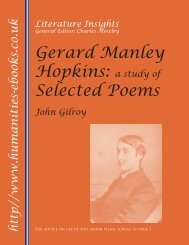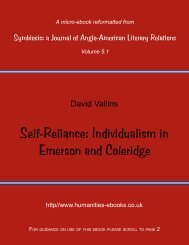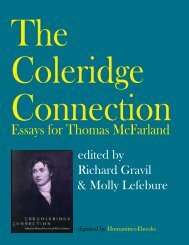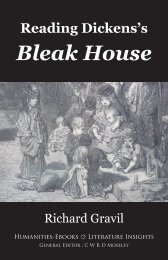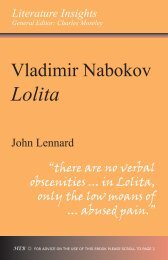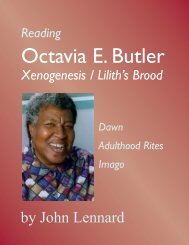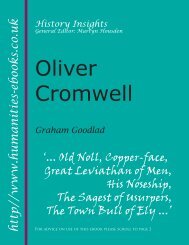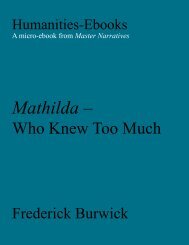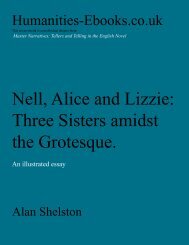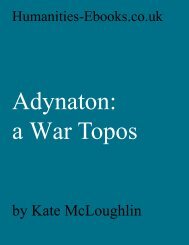General Editor - Humanities-Ebooks
General Editor - Humanities-Ebooks
General Editor - Humanities-Ebooks
Create successful ePaper yourself
Turn your PDF publications into a flip-book with our unique Google optimized e-Paper software.
Genre Fiction Monographs<br />
<strong>General</strong> <strong>Editor</strong>: John Lennard<br />
FOR<br />
LOVE<br />
AND<br />
MONEY<br />
The Literary Art<br />
of the Harlequin<br />
Mills & Boon Romance<br />
Laura Vivanco<br />
HEB ☼ FOR ADVICE ON THE USE OF THIS EBOOK PLEASE SCROLL TO PAGE 2
Reading t<br />
* This book is designed to be read in single page view, using the<br />
‘fit page’ command.<br />
* To navigate through the contents use the hyperlinked ‘Bookmarks’<br />
at the left of the screen.<br />
* To search, click the magnifying glass symbol and select ‘show<br />
all results’.<br />
* For ease of reading, use to enlarge the page to full<br />
screen, and return to normal view using < Esc >.<br />
* Hyperlinks (if any) appear in Blue Underlined Text.<br />
Permissions<br />
Your purchase of this ebook licenses you to read this work onscreen.<br />
No part of this publication may be otherwise reproduced or<br />
transmitted or distributed without the prior written permission of both<br />
the copyright owner and the publisher. You may print one copy of<br />
the book for your own use but copy and paste functions are disabled.<br />
Making or distributing copies of this book would constitute copyright<br />
infringement and would be liable to prosecution. Thank you for<br />
respecting the rights of the author.
<strong>Humanities</strong>-<strong>Ebooks</strong> Genre Fiction Monographs<br />
Series <strong>Editor</strong>: John Lennard<br />
For Love and Money<br />
The Literary Art of the Harlequin Mills & Boon<br />
Romance<br />
Laura Vivanco<br />
HEB ☼ <strong>Humanities</strong>-<strong>Ebooks</strong>
Copyright<br />
Text © Laura Vivanco 2011<br />
The author has asserted her right to be identified as the author of<br />
this Work in accordance with the Copyright, Designs and Patents Act<br />
1988.<br />
First published by <strong>Humanities</strong>-<strong>Ebooks</strong> LLP,<br />
Tirril Hall, Tirril, Penrith CA10 2JE.<br />
This PDF ebook is available from http://www.humanities-ebooks.<br />
co.uk and from MyiLibrary.com. and EBSCO. A Kindle ebook in<br />
reflowable format is available from Amazon.combut the Pdf is recommended<br />
for its superior performance on larger devices such as the<br />
Kindle DX, Dell Streak, and Apple iPad.<br />
A paperback is available from Lulu.com and from all booksellers.<br />
The author and publisher have used their best efforts to ensure that<br />
external URLs given in this book are accurate and current. They are<br />
not, however, responsible for any of these websites, and can offer no<br />
guarantee that the sites remain live or the content appropriate.<br />
ISBN 978-1-84760-195-7 PDF<br />
ISBN 978-1-84760-196-4 PAPERBACK<br />
ISBN 978-1-84760-197-1 KINDLE
To every Harlequin Mills & Boon author who has ever been asked<br />
“When are you going to write a real novel?”
Contents<br />
Copyright 4<br />
Acknowledgements 8<br />
Introduction 11<br />
Chapter 1. Mimetic Modes 29<br />
Myth 29<br />
The Romance Mode 31<br />
The High-Mimetic Mode 34<br />
The Low-Mimetic Mode 37<br />
The Ironic Mode 43<br />
Determining Mode 47<br />
Realism: Settings and Details 48<br />
Realism and the Happy Ending 50<br />
Realism: Issues 54<br />
Variations Within a Single Mode 61<br />
Modal Counterpoint 66<br />
Chapter 2. Mythoi 75<br />
Mythoi and Modes 78<br />
High Mimetic 79<br />
Low Mimetic 81<br />
Ironic 84<br />
Adapting Mythoi 91<br />
Chapter 3. Metafiction 109<br />
Defending Romance and its Readers 113<br />
Claiming Kinship with Classics 127<br />
Romance as Part of Popular Culture 133
Chapter 4. Metaphors 151<br />
Building a Relationship 155<br />
The Flowering of Romance 164<br />
Woman as Garden 164<br />
Woman as Flower 169<br />
The Hunt of Love 175<br />
Love is a Journey: Marion Lennox’s Princess of Convenience<br />
(2005) 183<br />
Conclusion 199<br />
Bibliography 204<br />
Harlequin Mills & Boon Romances 204<br />
Other Texts Cited 212
8 For Love and Money<br />
Acknowledgements<br />
My funding body and our child have been a great source of encouragement<br />
and technical help. Their belief in my work has kept me going<br />
on days when I was mired in the Slough of Despond.<br />
It has been a pleasure to be published by HEB. John Lennard’s<br />
enthusiasm, efficiency and attention to detail have made this a<br />
better book. Any remaining errors and omissions are, of course, my<br />
responsibility and not his.<br />
I am grateful to be part of a community of romance scholars and<br />
I would particularly like to acknowledge the vital roles played by<br />
Sarah S. G. Frantz (President of the International Association for<br />
the Study of Popular Romance), Pamela Regis (Vice President of<br />
IASPR and the author of A Natural History of the Romance Novel),<br />
and Eric M. Selinger (Executive <strong>Editor</strong> of the Journal of Popular<br />
Romance Studies and founder of the ‘Teach Me Tonight’ blog) in<br />
ensuring that the field is a lively and expanding one. Sandra Schwab<br />
marched ahead of me, slaying baggy dragons, An Goris made me<br />
aware of John Lennard’s Of Modern Dragons and Kerstin Frank’s<br />
introduction to the thermodynamics of Georgette Heyer fired me with<br />
enthusiasm for metaphors. I can only wish to match jay Dixon’s vast<br />
hoard of knowledge about Mills & Boon.<br />
Over the course of writing this book I corresponded with a number<br />
of HM&B authors, including Pamela Browning, Julie Cohen, Jennifer<br />
Crusie, Jessica Hart, Marion Lennox, Nicola Marsh, Sandra Marton,<br />
Sabrina Philips, Michelle Styles, Claire Thornton and Kate Walker.<br />
Their kindness is much appreciated.<br />
The readers of the ‘Teach Me Tonight’ blog made me believe there<br />
was also an audience for this project. Many of them gave me new<br />
perspectives on, and information about, romances. Joanna Chambers<br />
read and commented on sections of the book.<br />
Alan Deyermond remains an inspiration. I miss his incisive<br />
comments and value the encouragement he gave me as I began
Laura Vivanco 9<br />
work on this project. My conversations with him, Louise Haywood<br />
and Iona McCleery encouraged me to believe that in stepping from<br />
Hispano-medievalism into popular romance scholarship, I was not<br />
taking one giant leap into a totally unrelated field.<br />
I would also like to acknowledge the use, on the cover, of an adapted<br />
version of J. Herrera’s Diseño 3D, rosa roja which was made available<br />
online under a Creative Commons Attribution-Share Alike licence.<br />
The remixed version of the rose featured on the cover of this<br />
book is therefore available for use under the terms of that licence.
10 For Love and Money<br />
Abbreviations<br />
AD: Anno Domini (‘year of the Lord’)<br />
AIDS: Acquired Immune Deficiency Syndrome<br />
BBC: British Broadcasting Corporation<br />
BC: Before Christ<br />
ESP: extra-sensory perception<br />
HIV: Human Immunodeficiency Virus<br />
HM&B: Harlequin Mills & Boon<br />
IASPR: International Association for the Study of Popular Romance<br />
M&B: Mills & Boon<br />
MS: manuscript<br />
NHS: National Health Service (UK)<br />
N.Sh.OED: New Shorter Oxford English Dictionary<br />
OED: Oxford English Dictionary<br />
RCMP: Royal Canadian Mounted Police<br />
RWA: Romance Writers of America
Introduction<br />
When the editor of A Companion to Romance: From Classical to<br />
Contemporary (2004) “observed that: ‘Romance exists in degenerate<br />
form in works of the Mills & Boon type’”, Lynne Pearce responded:<br />
what is most degenerate is also most defining […]. Like it<br />
or not, it is the template originating in these mass-produced<br />
romances that has become the twenty-first-century’s base-line<br />
definition of romance. (521)<br />
The term ‘romance’, which “finds its origins in the French word<br />
romanz, meaning simply literature written in the vernacular, the romance<br />
language of French” (Saunders 2), has, however, been applied<br />
to a great many different types of literature:<br />
The word’s spectrum of meaning has to be wide to include<br />
Troilus and Criseyde, The Faerie Queene, The Mysteries of<br />
Udolpho and Lord Jim, all of which have been called romances.<br />
Keats and Hawthorne both claim the word for one of their<br />
works […]. One problem in discussing the romance is the<br />
need to limit the way the term is applied. (Beer 4–5)<br />
In this book the problem has been resolved by taking the novels published<br />
by Mills & Boon and Harlequin as “defining”: unless qualified<br />
in some way, any mention here of ‘romance’, ‘romances’ or ‘romance<br />
novels’ should be understood as referring to “works of the Mills &<br />
Boon type”.<br />
Mention will, however, be made of some of the works that have<br />
been recognised as relatives (some more distant than others) of the<br />
romance novel. Jean Radford, although she concedes that:<br />
It is possible to argue about ‘romance’ […] that there is no<br />
historical relationship between Greek ‘romances’, medieval
12 For Love and Money<br />
romance, Gothic bourgeois romances of the 1840s, late nineteenth<br />
century women’s romances and mass-produced romance<br />
fiction now—except the generic term. (8)<br />
nonetheless affirms that it “is also possible […] to give some weight<br />
to the claim that romance is one of the oldest and most enduring of<br />
literary modes which survives today” (8). If the claim is accepted,<br />
then popular mass-market romances, including Harlequin Mills &<br />
Boon (HM&B) romances, have extremely “deep taproots that lead all<br />
the way back through literary history to medieval romances, and to a<br />
pre-literary oral culture” (Holmes 6).<br />
The “Greek ‘romances’” to which Radford refers “were all written<br />
by and for the Greek-speaking population of the eastern Roman<br />
Empire, in the first, second and third centuries AD” (Williamson<br />
25). They include Heliodorus and Longus’s tales of “Chariclea and<br />
Theagenes, Daphnis and Chloe […] just a few of the lovers from<br />
centuries past who had delighted” (S. James 15) the heroine of<br />
Sophia James’s One Unashamed Night (2010). Their presence in this<br />
novel is one indication of modern authors’ awareness of the literary<br />
ancestors of HM&Bs; further proof of this awareness can be found<br />
in Chapter 3.<br />
What unifies texts:<br />
from Tristan and Iseult to the Harlequin series, is first the centrality<br />
of the love plot: what drives the plot, what motivates<br />
the turning of the pages, is the question of whether and how<br />
the two primary characters will achieve, or fail to achieve, a<br />
lasting union with each other. (Holmes 6)<br />
Romance novels, however, as published by HM&B and as defined by<br />
the Romance Writers of America (RWA), have both “a central love<br />
story and an emotionally satisfying and optimistic ending”. Or, in<br />
the words of Daphne Clair and Robyn Donald (both prolific HM&B<br />
authors), they tell “a story in which the plot is driven by a sexually<br />
based emotional relationship between two people. And for most readers<br />
there has to be a happy ending—or at least the strong implication<br />
of future happiness” (1). 1<br />
1 The RWA definition focuses on the two main aspects of romances but some
Laura Vivanco 13<br />
Mills & Boon, or Harlequin as the company is known in Canada<br />
and the US, has a unique relationship with romance:<br />
Mills & Boon, the United Kingdom’s leading publisher of romantic<br />
fiction, is one hundred years old in 2008; and its parent<br />
company, Harlequin, celebrates sixty years in 2009. Over the<br />
years, both firms have become household names, their books<br />
enjoying the almost unique distinction of being requested by<br />
publisher, rather than author. In 1997, the phrase ‘Mills &<br />
Boon’, meaning a type of popular romantic novel, was added<br />
to the Oxford English Dictionary. (Bowring and O’Brien 8) 1<br />
Ken Gelder has also stressed the importance of the publisher’s brand:<br />
“Harlequin and Mills and Boon have long been synonymous with<br />
romance, and it can certainly seem as if the brand name of the publisher<br />
overshadows the writer, who is quite literally subsumed into<br />
industry” (44).<br />
It would be wrong, however, to believe that all HM&B authors are<br />
“subsumed” into the company. In Mills & Boon’s early years its list:<br />
included the great and the near-great, some of whom were given<br />
their first big ‘break’ by Mills & Boon: P. G. Wodehouse,<br />
Hugh Walpole, Victor Bridges, Jack London, E. F. Benson,<br />
Georgette Heyer, Denise Robins, and Constance Holme were<br />
all published by the firm. (McAleer, Passion’s Fortune 3)<br />
This is also true of HM&B in more recent decades: the company has<br />
numbered among its authors Sally Beauman, Jennifer Crusie, Victoria<br />
Holt, Jayne Ann Krentz, Mercedes Lackey, Rosamunde Pilcher<br />
and Nora Roberts. 2 In addition, there are plenty of HM&B authors<br />
analysts of the genre have attempted to identify smaller constituent parts of the<br />
novels. Pamela Regis has described “eight essential narrative events [which]<br />
provide a romance novel with its basic structure” and “Three other narrative<br />
events [which] are frequent but not essential” (38). George Paizis has also analysed<br />
“the building blocks of the narratives” (Love 6).<br />
1 An indication of Harlequin’s status as a “household name” in North America is<br />
provided by Kay Mussell, who has noted that “Criticizing a film, novel, or television<br />
program as a ‘Harlequin romance’ has become an automatic phrase of<br />
contempt by reviewers who may never have read a romance” (16–17).<br />
2 As ‘Vanessa James’ Sally Beauman wrote nine romances for HM&B in the<br />
1980s. Jennifer Crusie’s career as an author began with Harlequin in the early
14 For Love and Money<br />
who, while they remain virtually unknown to the general public,<br />
are ‘stars’ to the publisher’s regular readers. This is a fact of which<br />
HM&B is well aware and “As readers begin to develop a preference<br />
for certain authors, so new reading programs are made available to<br />
cater to these demands” (Harlequin, Harlequin 30 th 12). 1<br />
Nonetheless, the fame (or notoriety) of the Harlequin and Mills<br />
& Boon brands has led many to think reductively of HM&B books<br />
as merely marketable commodities produced by a company whose<br />
“success has been reinforced through the application to the publishing<br />
industry of techniques developed in other areas of commerce” (Paizis,<br />
“Category” 130). Joseph McAleer, for example, states that:<br />
The Mills & Boon imprint, like any successful commodity in<br />
a mass market, stands for a quality product, a kind of guarantee<br />
of an easy, thrilling, and satisfying read with an obligatory<br />
happy ending. This flavourful confection, wrapped in a<br />
brightly coloured paperback cover with a dreamy scene, is to<br />
many addictive in its escapist nature. (Passion’s Fortune 2)<br />
Thus, although HM&B romances have been described as “an economic<br />
art form” (Jensen 32), they have rarely been judged positively<br />
as a literary art form. Rather, as Ann Curthoys and John Docker commented<br />
in 1990:<br />
For most of this century romance fiction […] has been high<br />
literature’s Other, a negative icon, what not, what never to<br />
1990s. ‘Victoria Holt’ was, like ‘Jean Plaidy’ and ‘Philippa Carr’, a pseudonym of<br />
Eleanor Hibbert (1906–93), who wrote romances for Mills & Boon in the 1950s<br />
and early 1960s as ‘Eleanor Burford’. Jayne Ann Krentz, who also writes as<br />
‘Amanda Quick’ and ‘Jayne Castle’, wrote for Harlequin in the 1980s and early<br />
1990s. Mercedes Lackey was already well known for her fantasy fiction before<br />
the first of her Five Hundred Kingdoms series, The Fairy Godmother (2004), was<br />
published by Harlequin’s LUNA imprint. As ‘Jane Fraser’ Rosamunde Pilcher<br />
wrote ten novels for Mills & Boon between 1949 and 1963. Nora Roberts has<br />
recently been described as “a publishing phenomenon. She writes five books a<br />
year—a hardcover novel, a paperback trilogy, and a paranormal suspense under<br />
the pseudonym J. D. Robb” (Gagne-Hawes). According to Roberts, discovering<br />
Harlequin romances was a “wonderful moment in my life” (“The Romance”<br />
198). She began her career writing category romances for Silhouette prior to its<br />
acquisition by Harlequin in 1984, and she remained with HM&B for many years.<br />
1 Such ‘star’ authors include Betty Neels, whose novels have been reprinted in<br />
special “Collector’s Editions”.
Laura Vivanco 15<br />
be. Newspaper critics in reviews, journalists in their columns,<br />
good professional-middle-class people in their conversation,<br />
would casually snap at a book or passage by saying things like<br />
‘it unfortunately smacks of Mills and Boon’, or, ‘in certain<br />
parts of the novel it lapses into pure Mills and Boon’. ‘Mills<br />
and Boon’ was a roaming, punitive signifier, a terrier running<br />
around and around the boundary that separates serious writing<br />
from the low, from sub-literature, para-literature, trash, schlock.<br />
‘Mills and Boon’ meant embarrassingly ‘bad’ writing,<br />
sentimental, over-explicit, slushy, sloppy, the lush, the unforgivable.<br />
(Curthoys & Docker)<br />
Many critics, including Daphne Watson and Kate Ellis, would doubtless<br />
have preferred to see the terrier impounded: the former believed<br />
that HM&B romance had crossed some literary boundary and was “a<br />
kind of subliterary form” (91), while the latter stated that “Harlequin<br />
romances […] are about as far from ‘great books’ as it is possible to<br />
get” (749).<br />
Similarly scathing assessments of this particular publisher’s list<br />
continue to be expressed:<br />
In the literary world, Mills and Boon has long been the black<br />
sheep. Its books—to call them novels would be to raise them<br />
far above their station—are lightweight, the plots recycled<br />
and the endings predictable and to read them is a waste of precious<br />
life. (Freeman)<br />
Having spent a great deal of time reading HM&B romances, I would<br />
argue that many are well-written, skilfully crafted works which can<br />
and do engage the minds as well as the emotions of their readers,<br />
and a few are small masterpieces—as I shall show. I follow in the<br />
footsteps of John G. Cawelti who considered “popular formulas to<br />
be of more complex artistic and cultural interest than most previous<br />
commentators have indicated” (Adventure 2) and stated that “it is<br />
possible to examine individual works of popular culture as unique<br />
artistic creations” (“The Concept” 382). 1 My choice of “individual<br />
1 Cawelti himself wrote little about the romance genre; in his Adventure, Mystery,<br />
and Romance he chose “to deal rather intensively with a few major formulas—
16 For Love and Money<br />
works” has been influenced by availability: most of the HM&Bs to<br />
which I refer were published in the UK in recent years. Nevertheless,<br />
the corpus of romances on which I draw spans seven decades and<br />
includes many novels edited in the US or Canada. I have also been<br />
guided by the need to quote from novels that provide clear examples<br />
of the topics under discussion.<br />
In analysing literary modes I have drawn heavily on the work of<br />
Northrop Frye, who observed that “Value-judgments are subjective<br />
[…]. When they are fashionable or generally accepted, they look<br />
objective, but that is all” (20). The truth of this is demonstrated by<br />
the history of the critical reception of an earlier form of romance<br />
literature, cancionero love poetry:<br />
For many years Hispanists have tended to assume that the<br />
huge numbers of lyric poems written in the fifteenth century—the<br />
so-called cancionero poetry, the work of some 700<br />
poets—were nothing more than, as it were, academic exercises<br />
ringing the changes on the trivial niceties of courtly love.<br />
(Wardropper 182)<br />
Keith Whinnom, however, set out to prove that:<br />
(1) the technical expertise of the composers of canciones is<br />
considerable; (2) the poets of the end of the fifteenth century<br />
accept in the canción a series of technical restrictions which<br />
make the canción at once a more exacting and a more concise<br />
form; (3) simultaneously they restrict their vocabulary to a<br />
very limited range of abstract terms; (4) the majority of modern<br />
critics who have looked at this verse have either dismissed<br />
it as vacuous and insipid or have singled out for enthusiastic<br />
approval poems which in form or content are quite untypical,<br />
and cannot be taken as representative of the aesthetic ideal of<br />
the period. (127)<br />
Despite his work, attitudes to cancionero poetry were slow to shift<br />
and in 1998 Julian Weiss observed that:<br />
various forms of detective and crime stories, the western, and the best-selling<br />
social melodrama” (2).
Laura Vivanco 17<br />
much of the work done on the cancioneros is still rooted in<br />
largely unexamined assumptions about literary canons, esthetic,<br />
social, and political categories and values. This is poetry<br />
that since the early nineteenth century has occupied a liminal<br />
space in the minds of critics. […] The history of cancionero<br />
studies is a measure of our evolving notions of “literature”<br />
and “culture,” since much of the interpretative criticism has<br />
been designed to vindicate or deny its status as “art.” (3)<br />
HM&B romances differ in many ways from late medieval cancionero<br />
poetry but both, despite being hugely popular with their intended<br />
audiences, have often been carelessly denigrated by modern scholars.<br />
As for the authors of these works, Ian Macpherson has noted of<br />
the cancionero poets that “I am personally convinced that many<br />
[…] were considerably more enterprising and ambitious […] than<br />
they have generally been given credit for” (62); one could say the<br />
same of romance novelists. In addition, both HM&B romances and<br />
cancionero love poetry are large bodies of work comprised of texts<br />
with “concise form[s]”. Although the lengths of HM&Bs vary, they<br />
are generally “concise” novels and the constraints imposed by their<br />
commercial niche prompted Jennifer Crusie, who has written for<br />
Harlequin, to compare them to poems: “Category [romance] is an<br />
elegant, exacting, exciting form of fiction. It requires precise pacing,<br />
tight plotting, and exquisitely brief characterizations. It is truly as<br />
fine a form for fiction as the sonnet is for poetry” (“So, Bill”). Dirk<br />
de Geest and An Goris have suggested that there are grounds for<br />
considering romances to be a type of “constrained writing”, a term<br />
which “designates a form of literary production in which the writer<br />
submits his or her text to specific formal (and to a lesser extent also<br />
thematic) constraints” (82).<br />
In the case of HM&B authors, many of the “specific formal (and<br />
to a lesser extent also thematic) constraints” are imposed by the<br />
publisher. Although Mills & Boon Limited, founded by Gerald Mills<br />
(1877–1928) and Charles Boon (1877–1943) in London in 1908,<br />
began its existence as a small general publisher, over time it came<br />
to specialise in romance novels. In 1957 Harlequin Books Limited, a<br />
small Canadian “printer, packager, and book distributor […] founded
18 For Love and Money<br />
in 1949 by Richard Bonnycastle” (McAleer, Passion’s Fortune 116–<br />
17), purchased the Canadian reprint rights for several Mills & Boon<br />
romances. Harlequin had also begun by printing works in a variety<br />
of genres, but it too came to specialise in romance as the business<br />
relationship between the two companies grew ever closer: in “1963<br />
Harlequin published a non-Mills & Boon author for the last time” and,<br />
on “1 October 1971, Harlequin acquired Mills & Boon” (McAleer,<br />
Passion’s Fortune 120, 139). The Mills & Boon brand, however,<br />
was retained and is used in the Australian, Indian, New Zealand and<br />
UK markets, while many of the company’s romances continue to be<br />
edited at Mills & Boon’s UK offices. In July 1984, Harlequin bought<br />
Silhouette Books from Simon & Schuster (Thurston 64) and until<br />
April 2011 Silhouette continued to exist as one of Harlequin’s many<br />
imprints:<br />
Harlequin sells books under several imprints including Harlequin,<br />
Silhouette, MIRA, […] Steeple Hill, LUNA and HQN.<br />
[…] In late 2005, Harlequin acquired the assets of BET Books,<br />
a leading publisher of African-American women’s fiction.<br />
These titles will be published by Harlequin under the Kimani<br />
Press imprint. (Torstar, 2005 Annual Report 25)<br />
Despite the fact that HM&B is best known for its ‘category’ or ‘series’<br />
romances, some of these imprints publish ‘single title’ novels<br />
and the company therefore:<br />
publishes books in both series and single title formats. Series<br />
titles are published monthly in mass-market paperback format<br />
under an imprint that identifies the type of story to the reader.<br />
Each series typically has a preset number of titles that will<br />
be published each month. The single title publishing program<br />
provides a broader spectrum of content in a variety of formats<br />
(mass-market paperback, trade paperback, hardcover) and is<br />
generally a lengthier book. (Torstar, 2010 Annual Report 12). 1<br />
1 It should be noted that not all of the books published by HM&B are romances.<br />
According to Harlequin’s website, the company “publishes over 110 titles a<br />
month […]. These books are written by over 1,200 talented authors worldwide,<br />
offering women a broad range of reading from romance to bestseller fiction,<br />
from young adult novels to erotic literature, from nonfiction to fantasy” (“About
Laura Vivanco 19<br />
Each series, or ‘line’, has its own guidelines which provide details<br />
about elements such as settings, levels of explicit sexual reference,<br />
and plot, which distinguish it from the other lines. Some lines specialise<br />
in particular areas, such as historical romance, medical romance,<br />
romantic suspense, and paranormal romance. These guidelines, then,<br />
serve as detailed descriptions of the constraints within which authors<br />
must work while still producing distinctive and emotionally engaging<br />
work.<br />
It may be helpful to compare HM&B authors to the Godmothers in<br />
Mercedes Lackey’s The Fairy Godmother (2004), a romantic fantasy<br />
novel published under Harlequin’s LUNA imprint. In the lands of the<br />
Five Hundred Kingdoms all of life is affected by a magic force known<br />
as “The Tradition” (58) which attempts to shape events to make them<br />
fit the patterns set by folktales, ballads, and other forms of traditional<br />
literature. The role of the Godmothers is to “see to it that the conditions<br />
are fulfilled to make things as pleasant as possible for everyone” (68).<br />
In order to achieve this they must become conversant with all aspects<br />
of “The Tradition” and a significant part of a Godmother’s training<br />
therefore involves making herself “familiar with every tale that any<br />
Godmother has ever been involved with” (90).<br />
Guides to writing romance novels suggest a similar programme<br />
of training for romance authors: Daphne Clair and Robyn Donald<br />
warn the aspiring author “Don’t try to write romances if you’ve never<br />
read one; you need to immerse yourself in them so you can recognise<br />
the clichés to avoid” (2), and Catherine Wade similarly suggests<br />
“Read as many novels as you can, selecting them from as many of<br />
the different types of romances as possible and reading the work of a<br />
large variety of authors” (15). 1 Harlequin explicitly advises would-be<br />
HM&B authors to read a wide range of their romances:<br />
we expect you to enjoy reading romance fiction. If you are<br />
already a fan, your appreciation for this type of book will be<br />
apparent in your writing. If you have not done so already, we<br />
encourage you to read many, many books from each series.<br />
Harlequin”).<br />
1 Catherine Wade writes for the Mills & Boon Modern/Harlequin Presents line of<br />
romances under the name ’Kate Walker’.
20 For Love and Money<br />
The series that emerges as your favorite is probably the one to<br />
which you should submit your manuscript. (“Writing Guidelines:<br />
How to”)<br />
Although it might be argued that by packaging the novels into ‘lines’,<br />
each with its own set of guidelines, HM&B restricts its authors’ artistic<br />
freedom, this in fact suggests that authors are encouraged to<br />
choose whichever line best suits their particular writing ‘voice’.<br />
It should also be noted that HM&B’s guidelines have not remained<br />
constant. McAleer describes one period of change, following<br />
Harlequin’s acquisition of Mills & Boon, in which:<br />
some of the authors who started their Mills & Boon careers<br />
in a more ‘chaste’ time […] were faced with the new requirements<br />
of the Harlequin era. ‘A lot of our authors who could<br />
not handle sex started to handle it,’ Boon said. ‘They probably<br />
read some of the authors who could and imitated it.’ Ethel<br />
Connell (‘Katrina Britt’) admitted that some of the older authors<br />
did just that: ‘A lot of the authors used to read each other,<br />
like in school. They’d have to copy the frisky bits.’ (Passion’s<br />
Fortune 287)<br />
Those who begin by imitating, however, may ultimately master the<br />
new techniques and themselves produce innovative novels. McAleer<br />
cites Anne Weale as an example of an author who “made the transition<br />
successfully” (Passion’s Fortune 287) and “demonstrated her<br />
newfound talents in two ground-breaking novels” (288). Although<br />
the casual or infrequent reader is perhaps more apt to perceive the<br />
similarities between HM&B novels, Eva Hemmungs Wirtén suggests<br />
that:<br />
a very real experience of originality and individuality […] exists,<br />
not as a result of readers being tricked or duped into consumption<br />
and reading, but as a tangible reality stemming from<br />
an acquired reading competence that allow[s] texts that are<br />
written within category romance to be understood as different<br />
from one another, as having something unique in them. In a<br />
way, a text should adhere to the requirements of a particular<br />
line, but also in a sense break out of that frame. (74)
To Buy This Book<br />
If this is what you are looking for please<br />
Buy this Book<br />
or<br />
Browse our lists<br />
Pdf Ebook Features:<br />
elegantly formatted<br />
fixed page formats are easily cited<br />
high quality graphics<br />
internal and external hyperlinks<br />
easy navigation by bookmarks<br />
ideal for laptops, desktops and tablets<br />
The book is yours to keep - and a copy is stored on<br />
your bookshelf in case you lose it.<br />
We also sell:<br />
Kindle editions from Amazon.com and Amazon.co.uk<br />
Paperbacks from Lulu.com and Troubador.co.uk<br />
Library Editions from MyiLibrary and EBSCO



